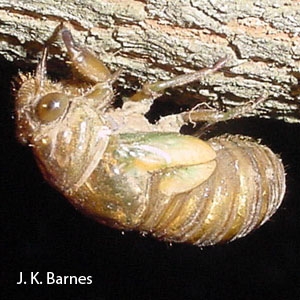Dog day cicadas
Order: Hemiptera
Family: Cicadidae
Genus and species: Tibicen spp.


Cicadas are easily recognized by their large size, 1–2 inches in length, their characteristic shape, with transparent wings held tent-like over the abdomen, and the presence of 3 ocelli , or simple eyes, in addition to the widely separated compound eyes. There are some 3000 species of cicadas worldwide and around 160 species in the United States. Most of them take 2–8 years to mature and emerge as adults. Unlike the periodical cicadas of eastern North America, most species do not have synchronized life cycles, and some adults will emerge in the same area every year. They are thus called annual cicadas to distinguish them from periodical cicadas.
Cicadas belonging to the genus Tibicen are large-bodied, black cicadas, usually with green and brown markings. These are the “dog day” cicadas or “harvestflies” of late summer and fall. Adults emerge each year in July and August, during the hot and sultry “dog days” of summer. Those summer days are marked in our collective memories by the sounds of the so-called “singing locusts,” which are in fact cicadas, however entomologists prefer to reserve the term locust for migratory grasshoppers. Males of nearly all cicada species produce songs from a pair of tymbals, ridged membranes found on the sides of the first abdominal segment. In the genus Tibicen, the tymbals are covered above by an abdominal flap. The tympana, or hearing organs, are located below the tymbals. The abdomen of a male cicada is hollow and acts as a resonance chamber. Males produce their loud calls in the afternoon and evening, depending on the species. The calls attract females. Each species has a characteristic sound by which it can be identified. The common silver-bellied or scissor grinder cicada, Tibicen pruinosa, makes a loud, pulsed weeee-oh, weeee-oh, weeee-oh, weeee-oh sound from late afternoon until dark. The buzz saw cicada, T. lyricen, makes a monotonous zzzzzzzzz racket.
The various species of Tibicen are temporally and spatially separated. Tibicen pruinosa emerges in mid July to early August, while T. aurifera and T. dorsataemerge from early August to mid September. Tibicen pruinosa and T. lyricen emerge exclusively from forested habitats. Tibicen aurifera and T. dorsata are most likely to emerge from prairie habitats.
Many species of animals feed on dog day cicadas. The female cicada killer wasp paralyzes a cicada, drags it underground, and lays its eggs on the victim. After hatching, the larva feeds on the stunned, but still living, cicada. The most common cicada in Arkansas, Tibicen pruinosa, has been found to be the favorite insect prey of copperhead snakes. The snakes catch them as mature nymphs that have just emerged from the ground, or as soft, teneral adults.
Cicadas do not harm human beings, although a male can frighten a person who decides to handle it. The alarm sound it makes is loud and shocking.
